Ethical Dilemma at Workplace: A Case Study Analysis and Reflection
VerifiedAdded on 2022/09/01
|11
|2765
|28
Report
AI Summary
This report presents an analysis of an ethical dilemma encountered in a small start-up company's research and development team. The scenario involves a situation where two team members took credit for a project, excluding the third member. The report delves into the details of the situation, including the roles of each team member, the timeline of events, and the conflicting values at play. It explores the thoughts and feelings of the involved individuals and describes the actions taken to address the issue. Furthermore, the report provides an analysis using normative ethical theories, specifically consequentialism (including utilitarianism) and non-consequentialism (including virtue ethics), to evaluate the ethical dimensions of the dilemma. The application of these theories helps to understand the motivations and consequences of the actions taken. Finally, the report includes reflections on the ethical theories, their impact on understanding the situation, and alternative courses of action that could have been taken. The reflection also considers how the ethical theories provided insights into the actions taken by the student.

Running head: - ETHICAL DILEMMA AT WORKPLACE
ETHICAL DILEMMA AT WORKPLACE
Name of the Student
Name of the University
Author Note
ETHICAL DILEMMA AT WORKPLACE
Name of the Student
Name of the University
Author Note
Paraphrase This Document
Need a fresh take? Get an instant paraphrase of this document with our AI Paraphraser
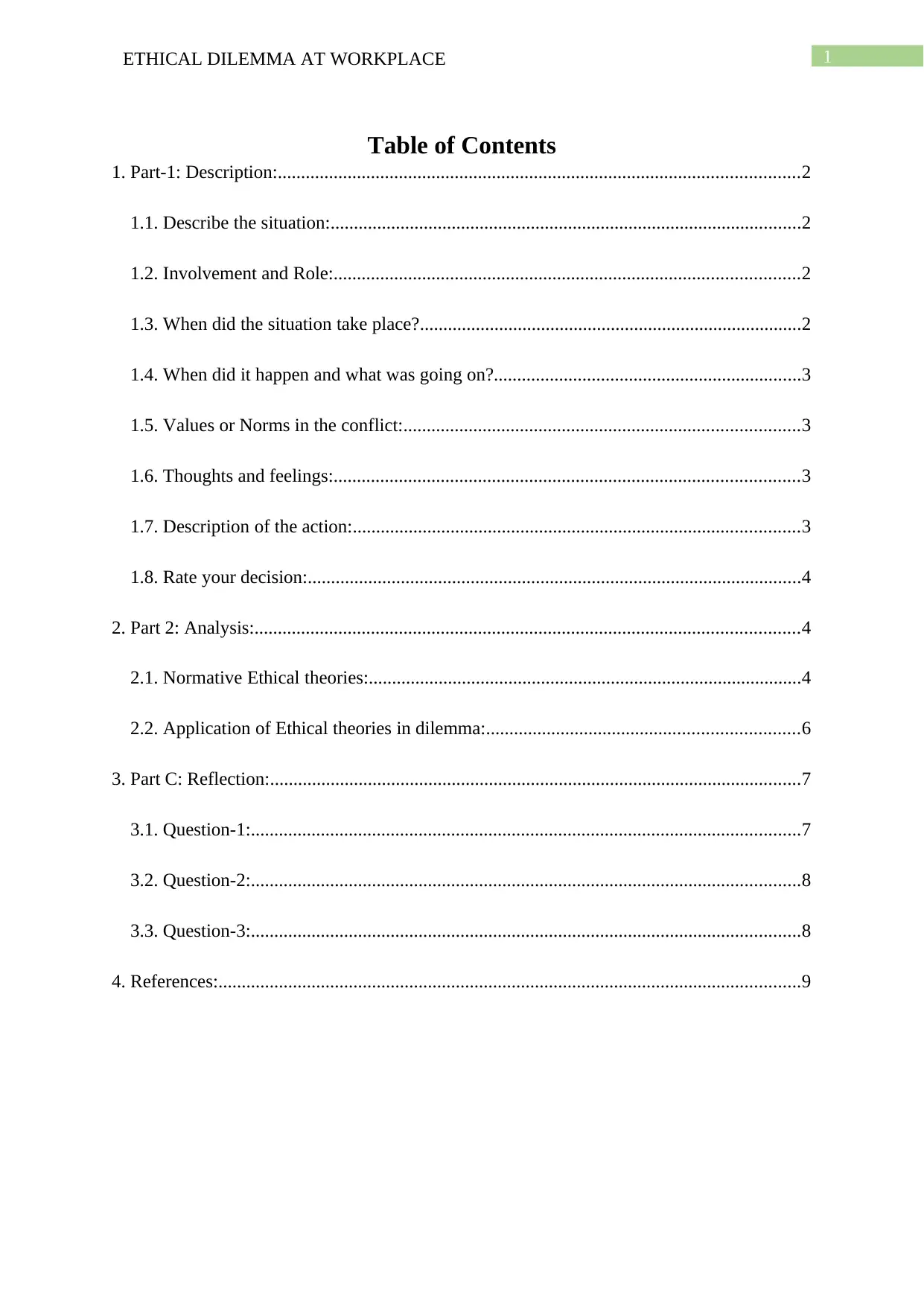
1ETHICAL DILEMMA AT WORKPLACE
Table of Contents
1. Part-1: Description:................................................................................................................2
1.1. Describe the situation:.....................................................................................................2
1.2. Involvement and Role:....................................................................................................2
1.3. When did the situation take place?..................................................................................2
1.4. When did it happen and what was going on?..................................................................3
1.5. Values or Norms in the conflict:.....................................................................................3
1.6. Thoughts and feelings:....................................................................................................3
1.7. Description of the action:................................................................................................3
1.8. Rate your decision:..........................................................................................................4
2. Part 2: Analysis:.....................................................................................................................4
2.1. Normative Ethical theories:.............................................................................................4
2.2. Application of Ethical theories in dilemma:...................................................................6
3. Part C: Reflection:..................................................................................................................7
3.1. Question-1:......................................................................................................................7
3.2. Question-2:......................................................................................................................8
3.3. Question-3:......................................................................................................................8
4. References:.............................................................................................................................9
Table of Contents
1. Part-1: Description:................................................................................................................2
1.1. Describe the situation:.....................................................................................................2
1.2. Involvement and Role:....................................................................................................2
1.3. When did the situation take place?..................................................................................2
1.4. When did it happen and what was going on?..................................................................3
1.5. Values or Norms in the conflict:.....................................................................................3
1.6. Thoughts and feelings:....................................................................................................3
1.7. Description of the action:................................................................................................3
1.8. Rate your decision:..........................................................................................................4
2. Part 2: Analysis:.....................................................................................................................4
2.1. Normative Ethical theories:.............................................................................................4
2.2. Application of Ethical theories in dilemma:...................................................................6
3. Part C: Reflection:..................................................................................................................7
3.1. Question-1:......................................................................................................................7
3.2. Question-2:......................................................................................................................8
3.3. Question-3:......................................................................................................................8
4. References:.............................................................................................................................9

2ETHICAL DILEMMA AT WORKPLACE
1. Part-1: Description:
1.1. Describe the situation:
The small start-up company had a research and development team that consisted of
three people working as team leader, named Jack, Ryan and Taylor. Jack worked towards
developing the frontend of the websites, Ryan did all the connections between the backend
and the frontend of the websites and Taylor did the entire backend upon which, the entire
website is working.
Three of them had recently accomplished a project that was booked by the client on
an urgent basis with no more than 2 days of time in hand (Butler 2018). However, when
called upon by the manager inside the manager’s chamber Jack and Taylor took all the credit
of developing the entire website that was booked and Ryan was left out of any credit.
Hence, the situation was of this kind where two of the teammates took the credit,
leaving the third one aside.
1.2. Involvement and Role:
In the scenario that has been described, primarily three people have been found to be
involved in the scenario. Jack who designs the frontend and the look of all the websites
(Kagan 2018). Ryan, who makes the connections and Taylor who codes the backend of the
websites.
Ryan was the person who was left out of all the credit inside the managers room for
being a primary component within the urgent project that was delivered.
1.3. When did the situation take place?
The situation primarily occurred when three of the project team members had been
called inside the manager’s office for recognition and rewards to deliver such an urgent
1. Part-1: Description:
1.1. Describe the situation:
The small start-up company had a research and development team that consisted of
three people working as team leader, named Jack, Ryan and Taylor. Jack worked towards
developing the frontend of the websites, Ryan did all the connections between the backend
and the frontend of the websites and Taylor did the entire backend upon which, the entire
website is working.
Three of them had recently accomplished a project that was booked by the client on
an urgent basis with no more than 2 days of time in hand (Butler 2018). However, when
called upon by the manager inside the manager’s chamber Jack and Taylor took all the credit
of developing the entire website that was booked and Ryan was left out of any credit.
Hence, the situation was of this kind where two of the teammates took the credit,
leaving the third one aside.
1.2. Involvement and Role:
In the scenario that has been described, primarily three people have been found to be
involved in the scenario. Jack who designs the frontend and the look of all the websites
(Kagan 2018). Ryan, who makes the connections and Taylor who codes the backend of the
websites.
Ryan was the person who was left out of all the credit inside the managers room for
being a primary component within the urgent project that was delivered.
1.3. When did the situation take place?
The situation primarily occurred when three of the project team members had been
called inside the manager’s office for recognition and rewards to deliver such an urgent
⊘ This is a preview!⊘
Do you want full access?
Subscribe today to unlock all pages.

Trusted by 1+ million students worldwide
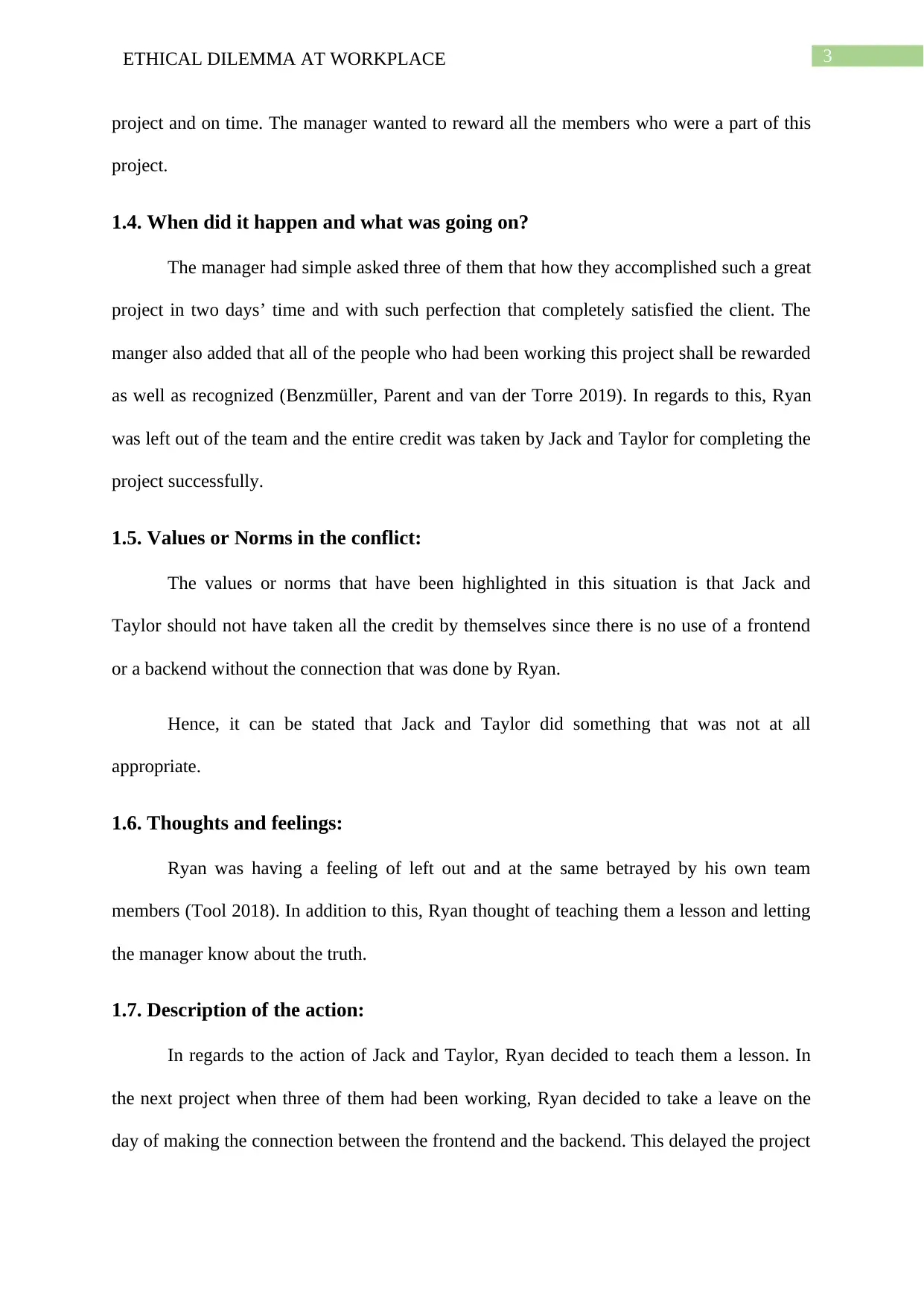
3ETHICAL DILEMMA AT WORKPLACE
project and on time. The manager wanted to reward all the members who were a part of this
project.
1.4. When did it happen and what was going on?
The manager had simple asked three of them that how they accomplished such a great
project in two days’ time and with such perfection that completely satisfied the client. The
manger also added that all of the people who had been working this project shall be rewarded
as well as recognized (Benzmüller, Parent and van der Torre 2019). In regards to this, Ryan
was left out of the team and the entire credit was taken by Jack and Taylor for completing the
project successfully.
1.5. Values or Norms in the conflict:
The values or norms that have been highlighted in this situation is that Jack and
Taylor should not have taken all the credit by themselves since there is no use of a frontend
or a backend without the connection that was done by Ryan.
Hence, it can be stated that Jack and Taylor did something that was not at all
appropriate.
1.6. Thoughts and feelings:
Ryan was having a feeling of left out and at the same betrayed by his own team
members (Tool 2018). In addition to this, Ryan thought of teaching them a lesson and letting
the manager know about the truth.
1.7. Description of the action:
In regards to the action of Jack and Taylor, Ryan decided to teach them a lesson. In
the next project when three of them had been working, Ryan decided to take a leave on the
day of making the connection between the frontend and the backend. This delayed the project
project and on time. The manager wanted to reward all the members who were a part of this
project.
1.4. When did it happen and what was going on?
The manager had simple asked three of them that how they accomplished such a great
project in two days’ time and with such perfection that completely satisfied the client. The
manger also added that all of the people who had been working this project shall be rewarded
as well as recognized (Benzmüller, Parent and van der Torre 2019). In regards to this, Ryan
was left out of the team and the entire credit was taken by Jack and Taylor for completing the
project successfully.
1.5. Values or Norms in the conflict:
The values or norms that have been highlighted in this situation is that Jack and
Taylor should not have taken all the credit by themselves since there is no use of a frontend
or a backend without the connection that was done by Ryan.
Hence, it can be stated that Jack and Taylor did something that was not at all
appropriate.
1.6. Thoughts and feelings:
Ryan was having a feeling of left out and at the same betrayed by his own team
members (Tool 2018). In addition to this, Ryan thought of teaching them a lesson and letting
the manager know about the truth.
1.7. Description of the action:
In regards to the action of Jack and Taylor, Ryan decided to teach them a lesson. In
the next project when three of them had been working, Ryan decided to take a leave on the
day of making the connection between the frontend and the backend. This delayed the project
Paraphrase This Document
Need a fresh take? Get an instant paraphrase of this document with our AI Paraphraser
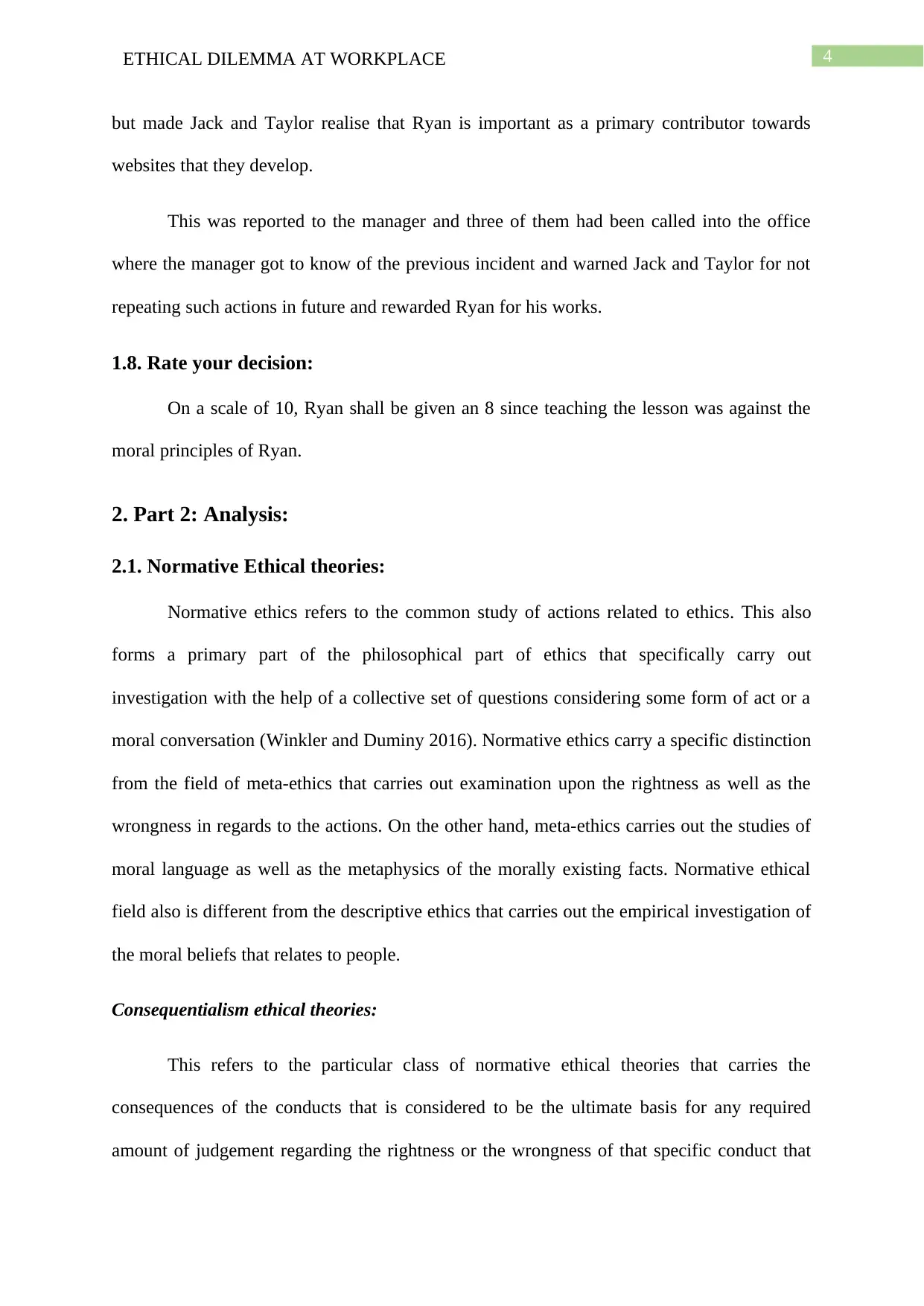
4ETHICAL DILEMMA AT WORKPLACE
but made Jack and Taylor realise that Ryan is important as a primary contributor towards
websites that they develop.
This was reported to the manager and three of them had been called into the office
where the manager got to know of the previous incident and warned Jack and Taylor for not
repeating such actions in future and rewarded Ryan for his works.
1.8. Rate your decision:
On a scale of 10, Ryan shall be given an 8 since teaching the lesson was against the
moral principles of Ryan.
2. Part 2: Analysis:
2.1. Normative Ethical theories:
Normative ethics refers to the common study of actions related to ethics. This also
forms a primary part of the philosophical part of ethics that specifically carry out
investigation with the help of a collective set of questions considering some form of act or a
moral conversation (Winkler and Duminy 2016). Normative ethics carry a specific distinction
from the field of meta-ethics that carries out examination upon the rightness as well as the
wrongness in regards to the actions. On the other hand, meta-ethics carries out the studies of
moral language as well as the metaphysics of the morally existing facts. Normative ethical
field also is different from the descriptive ethics that carries out the empirical investigation of
the moral beliefs that relates to people.
Consequentialism ethical theories:
This refers to the particular class of normative ethical theories that carries the
consequences of the conducts that is considered to be the ultimate basis for any required
amount of judgement regarding the rightness or the wrongness of that specific conduct that
but made Jack and Taylor realise that Ryan is important as a primary contributor towards
websites that they develop.
This was reported to the manager and three of them had been called into the office
where the manager got to know of the previous incident and warned Jack and Taylor for not
repeating such actions in future and rewarded Ryan for his works.
1.8. Rate your decision:
On a scale of 10, Ryan shall be given an 8 since teaching the lesson was against the
moral principles of Ryan.
2. Part 2: Analysis:
2.1. Normative Ethical theories:
Normative ethics refers to the common study of actions related to ethics. This also
forms a primary part of the philosophical part of ethics that specifically carry out
investigation with the help of a collective set of questions considering some form of act or a
moral conversation (Winkler and Duminy 2016). Normative ethics carry a specific distinction
from the field of meta-ethics that carries out examination upon the rightness as well as the
wrongness in regards to the actions. On the other hand, meta-ethics carries out the studies of
moral language as well as the metaphysics of the morally existing facts. Normative ethical
field also is different from the descriptive ethics that carries out the empirical investigation of
the moral beliefs that relates to people.
Consequentialism ethical theories:
This refers to the particular class of normative ethical theories that carries the
consequences of the conducts that is considered to be the ultimate basis for any required
amount of judgement regarding the rightness or the wrongness of that specific conduct that
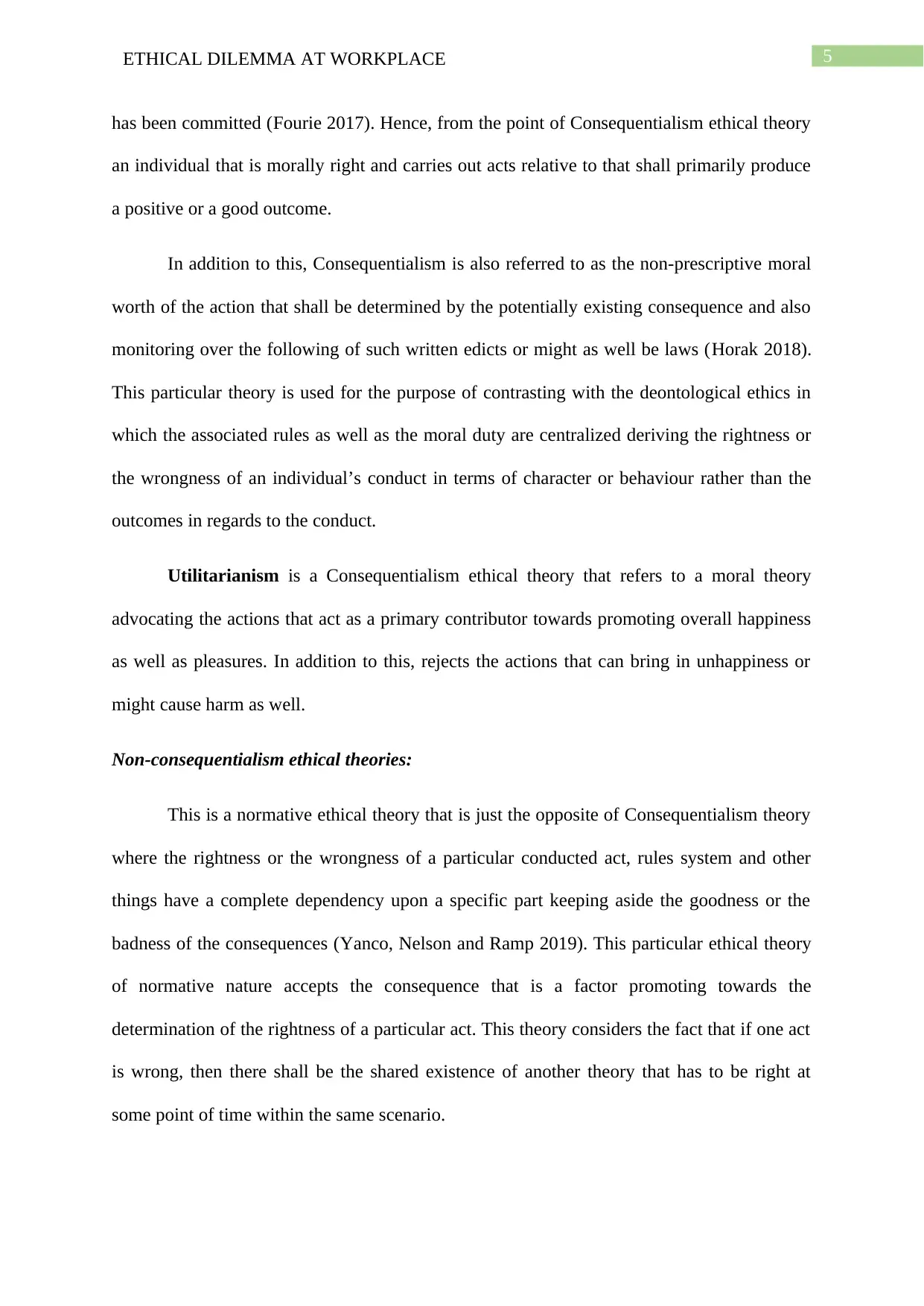
5ETHICAL DILEMMA AT WORKPLACE
has been committed (Fourie 2017). Hence, from the point of Consequentialism ethical theory
an individual that is morally right and carries out acts relative to that shall primarily produce
a positive or a good outcome.
In addition to this, Consequentialism is also referred to as the non-prescriptive moral
worth of the action that shall be determined by the potentially existing consequence and also
monitoring over the following of such written edicts or might as well be laws (Horak 2018).
This particular theory is used for the purpose of contrasting with the deontological ethics in
which the associated rules as well as the moral duty are centralized deriving the rightness or
the wrongness of an individual’s conduct in terms of character or behaviour rather than the
outcomes in regards to the conduct.
Utilitarianism is a Consequentialism ethical theory that refers to a moral theory
advocating the actions that act as a primary contributor towards promoting overall happiness
as well as pleasures. In addition to this, rejects the actions that can bring in unhappiness or
might cause harm as well.
Non-consequentialism ethical theories:
This is a normative ethical theory that is just the opposite of Consequentialism theory
where the rightness or the wrongness of a particular conducted act, rules system and other
things have a complete dependency upon a specific part keeping aside the goodness or the
badness of the consequences (Yanco, Nelson and Ramp 2019). This particular ethical theory
of normative nature accepts the consequence that is a factor promoting towards the
determination of the rightness of a particular act. This theory considers the fact that if one act
is wrong, then there shall be the shared existence of another theory that has to be right at
some point of time within the same scenario.
has been committed (Fourie 2017). Hence, from the point of Consequentialism ethical theory
an individual that is morally right and carries out acts relative to that shall primarily produce
a positive or a good outcome.
In addition to this, Consequentialism is also referred to as the non-prescriptive moral
worth of the action that shall be determined by the potentially existing consequence and also
monitoring over the following of such written edicts or might as well be laws (Horak 2018).
This particular theory is used for the purpose of contrasting with the deontological ethics in
which the associated rules as well as the moral duty are centralized deriving the rightness or
the wrongness of an individual’s conduct in terms of character or behaviour rather than the
outcomes in regards to the conduct.
Utilitarianism is a Consequentialism ethical theory that refers to a moral theory
advocating the actions that act as a primary contributor towards promoting overall happiness
as well as pleasures. In addition to this, rejects the actions that can bring in unhappiness or
might cause harm as well.
Non-consequentialism ethical theories:
This is a normative ethical theory that is just the opposite of Consequentialism theory
where the rightness or the wrongness of a particular conducted act, rules system and other
things have a complete dependency upon a specific part keeping aside the goodness or the
badness of the consequences (Yanco, Nelson and Ramp 2019). This particular ethical theory
of normative nature accepts the consequence that is a factor promoting towards the
determination of the rightness of a particular act. This theory considers the fact that if one act
is wrong, then there shall be the shared existence of another theory that has to be right at
some point of time within the same scenario.
⊘ This is a preview!⊘
Do you want full access?
Subscribe today to unlock all pages.

Trusted by 1+ million students worldwide
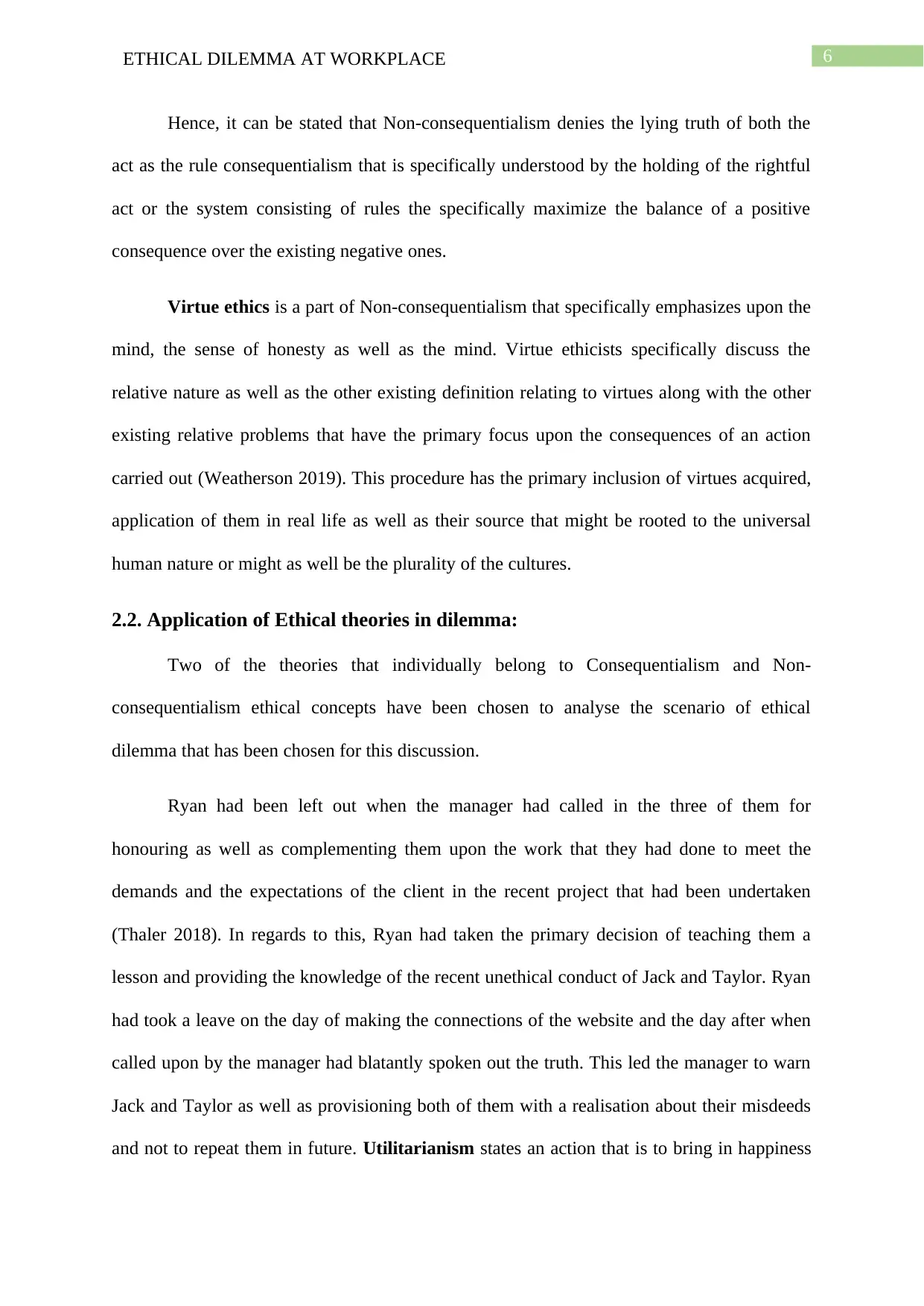
6ETHICAL DILEMMA AT WORKPLACE
Hence, it can be stated that Non-consequentialism denies the lying truth of both the
act as the rule consequentialism that is specifically understood by the holding of the rightful
act or the system consisting of rules the specifically maximize the balance of a positive
consequence over the existing negative ones.
Virtue ethics is a part of Non-consequentialism that specifically emphasizes upon the
mind, the sense of honesty as well as the mind. Virtue ethicists specifically discuss the
relative nature as well as the other existing definition relating to virtues along with the other
existing relative problems that have the primary focus upon the consequences of an action
carried out (Weatherson 2019). This procedure has the primary inclusion of virtues acquired,
application of them in real life as well as their source that might be rooted to the universal
human nature or might as well be the plurality of the cultures.
2.2. Application of Ethical theories in dilemma:
Two of the theories that individually belong to Consequentialism and Non-
consequentialism ethical concepts have been chosen to analyse the scenario of ethical
dilemma that has been chosen for this discussion.
Ryan had been left out when the manager had called in the three of them for
honouring as well as complementing them upon the work that they had done to meet the
demands and the expectations of the client in the recent project that had been undertaken
(Thaler 2018). In regards to this, Ryan had taken the primary decision of teaching them a
lesson and providing the knowledge of the recent unethical conduct of Jack and Taylor. Ryan
had took a leave on the day of making the connections of the website and the day after when
called upon by the manager had blatantly spoken out the truth. This led the manager to warn
Jack and Taylor as well as provisioning both of them with a realisation about their misdeeds
and not to repeat them in future. Utilitarianism states an action that is to bring in happiness
Hence, it can be stated that Non-consequentialism denies the lying truth of both the
act as the rule consequentialism that is specifically understood by the holding of the rightful
act or the system consisting of rules the specifically maximize the balance of a positive
consequence over the existing negative ones.
Virtue ethics is a part of Non-consequentialism that specifically emphasizes upon the
mind, the sense of honesty as well as the mind. Virtue ethicists specifically discuss the
relative nature as well as the other existing definition relating to virtues along with the other
existing relative problems that have the primary focus upon the consequences of an action
carried out (Weatherson 2019). This procedure has the primary inclusion of virtues acquired,
application of them in real life as well as their source that might be rooted to the universal
human nature or might as well be the plurality of the cultures.
2.2. Application of Ethical theories in dilemma:
Two of the theories that individually belong to Consequentialism and Non-
consequentialism ethical concepts have been chosen to analyse the scenario of ethical
dilemma that has been chosen for this discussion.
Ryan had been left out when the manager had called in the three of them for
honouring as well as complementing them upon the work that they had done to meet the
demands and the expectations of the client in the recent project that had been undertaken
(Thaler 2018). In regards to this, Ryan had taken the primary decision of teaching them a
lesson and providing the knowledge of the recent unethical conduct of Jack and Taylor. Ryan
had took a leave on the day of making the connections of the website and the day after when
called upon by the manager had blatantly spoken out the truth. This led the manager to warn
Jack and Taylor as well as provisioning both of them with a realisation about their misdeeds
and not to repeat them in future. Utilitarianism states an action that is to bring in happiness
Paraphrase This Document
Need a fresh take? Get an instant paraphrase of this document with our AI Paraphraser
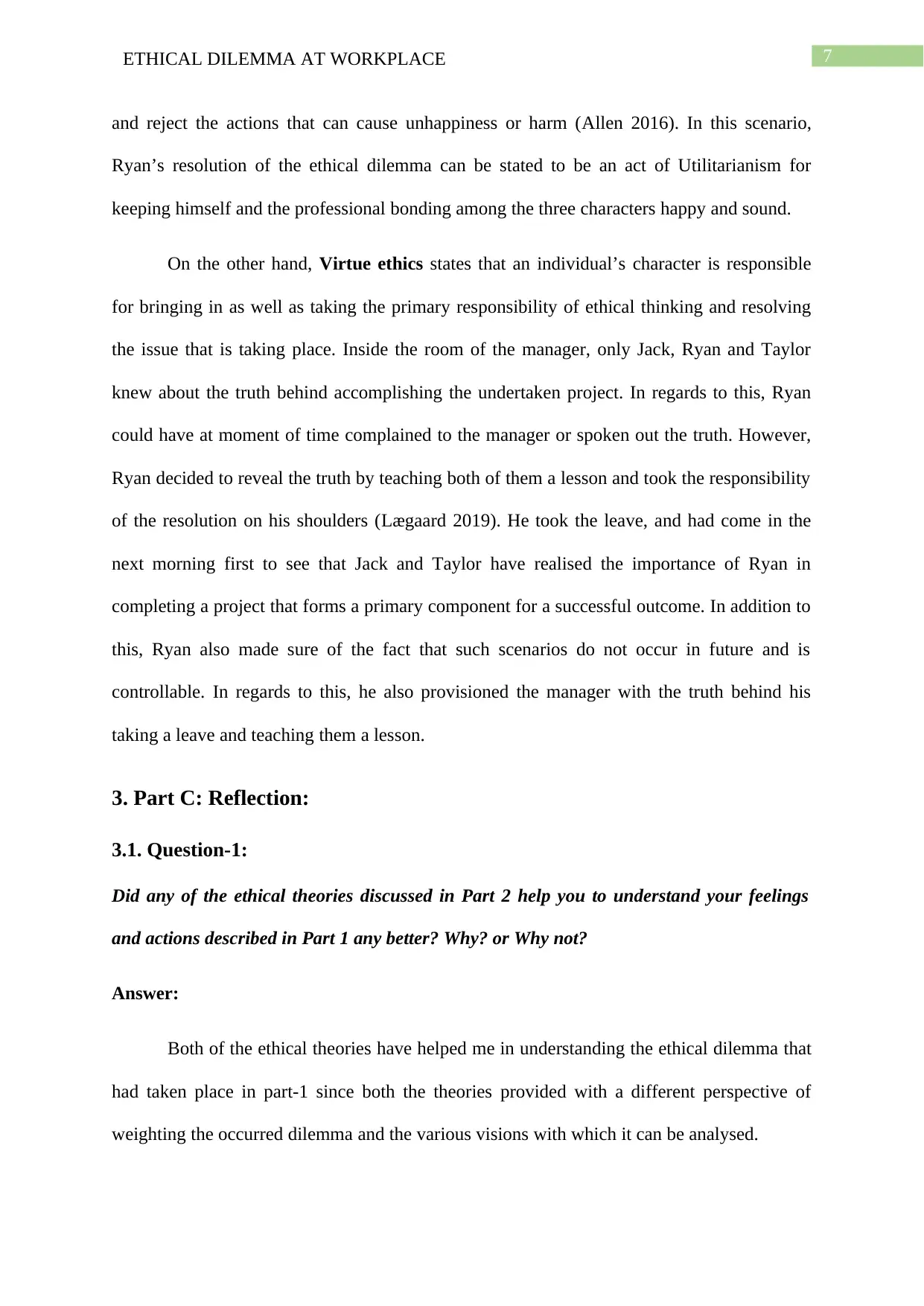
7ETHICAL DILEMMA AT WORKPLACE
and reject the actions that can cause unhappiness or harm (Allen 2016). In this scenario,
Ryan’s resolution of the ethical dilemma can be stated to be an act of Utilitarianism for
keeping himself and the professional bonding among the three characters happy and sound.
On the other hand, Virtue ethics states that an individual’s character is responsible
for bringing in as well as taking the primary responsibility of ethical thinking and resolving
the issue that is taking place. Inside the room of the manager, only Jack, Ryan and Taylor
knew about the truth behind accomplishing the undertaken project. In regards to this, Ryan
could have at moment of time complained to the manager or spoken out the truth. However,
Ryan decided to reveal the truth by teaching both of them a lesson and took the responsibility
of the resolution on his shoulders (Lægaard 2019). He took the leave, and had come in the
next morning first to see that Jack and Taylor have realised the importance of Ryan in
completing a project that forms a primary component for a successful outcome. In addition to
this, Ryan also made sure of the fact that such scenarios do not occur in future and is
controllable. In regards to this, he also provisioned the manager with the truth behind his
taking a leave and teaching them a lesson.
3. Part C: Reflection:
3.1. Question-1:
Did any of the ethical theories discussed in Part 2 help you to understand your feelings
and actions described in Part 1 any better? Why? or Why not?
Answer:
Both of the ethical theories have helped me in understanding the ethical dilemma that
had taken place in part-1 since both the theories provided with a different perspective of
weighting the occurred dilemma and the various visions with which it can be analysed.
and reject the actions that can cause unhappiness or harm (Allen 2016). In this scenario,
Ryan’s resolution of the ethical dilemma can be stated to be an act of Utilitarianism for
keeping himself and the professional bonding among the three characters happy and sound.
On the other hand, Virtue ethics states that an individual’s character is responsible
for bringing in as well as taking the primary responsibility of ethical thinking and resolving
the issue that is taking place. Inside the room of the manager, only Jack, Ryan and Taylor
knew about the truth behind accomplishing the undertaken project. In regards to this, Ryan
could have at moment of time complained to the manager or spoken out the truth. However,
Ryan decided to reveal the truth by teaching both of them a lesson and took the responsibility
of the resolution on his shoulders (Lægaard 2019). He took the leave, and had come in the
next morning first to see that Jack and Taylor have realised the importance of Ryan in
completing a project that forms a primary component for a successful outcome. In addition to
this, Ryan also made sure of the fact that such scenarios do not occur in future and is
controllable. In regards to this, he also provisioned the manager with the truth behind his
taking a leave and teaching them a lesson.
3. Part C: Reflection:
3.1. Question-1:
Did any of the ethical theories discussed in Part 2 help you to understand your feelings
and actions described in Part 1 any better? Why? or Why not?
Answer:
Both of the ethical theories have helped me in understanding the ethical dilemma that
had taken place in part-1 since both the theories provided with a different perspective of
weighting the occurred dilemma and the various visions with which it can be analysed.
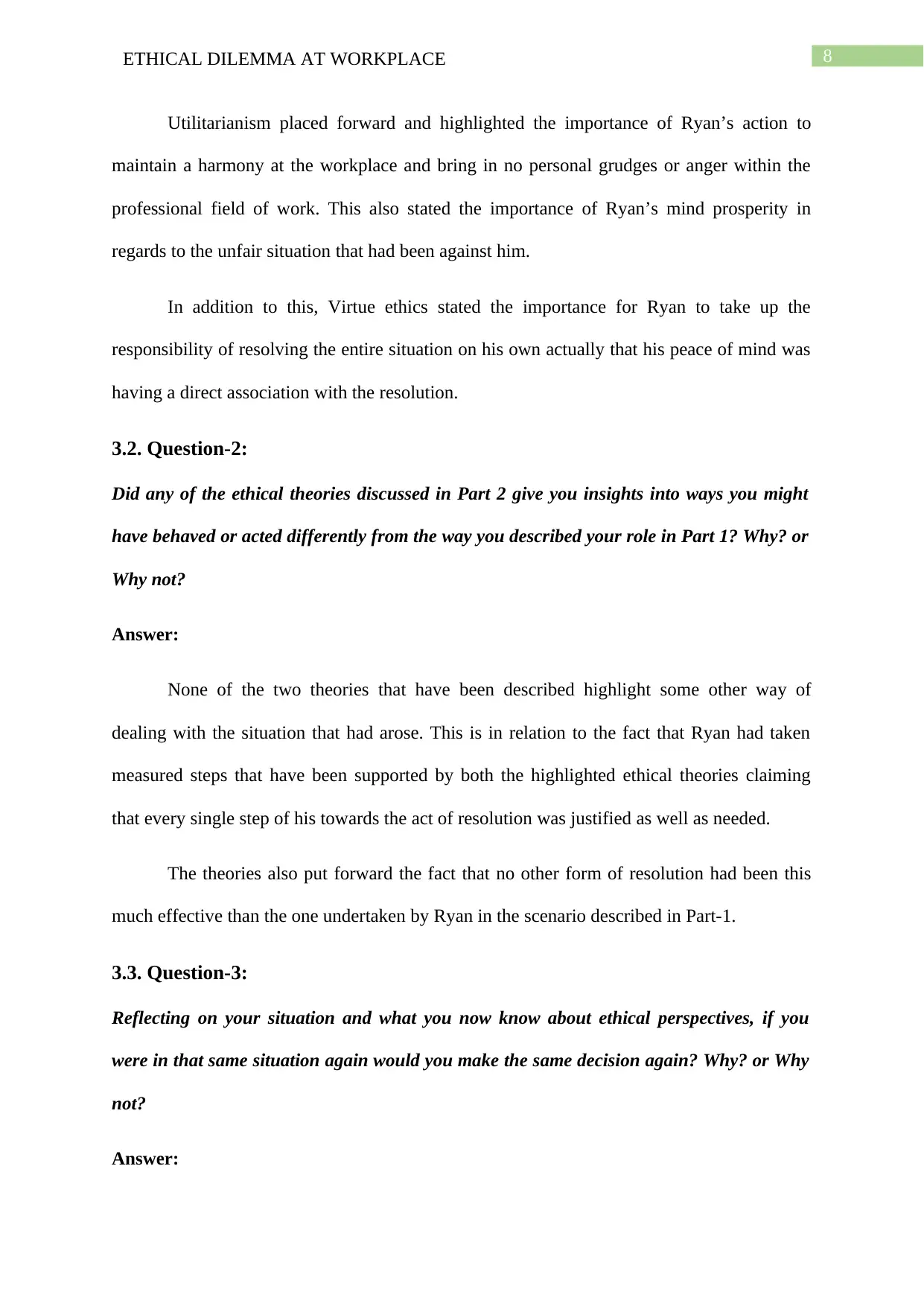
8ETHICAL DILEMMA AT WORKPLACE
Utilitarianism placed forward and highlighted the importance of Ryan’s action to
maintain a harmony at the workplace and bring in no personal grudges or anger within the
professional field of work. This also stated the importance of Ryan’s mind prosperity in
regards to the unfair situation that had been against him.
In addition to this, Virtue ethics stated the importance for Ryan to take up the
responsibility of resolving the entire situation on his own actually that his peace of mind was
having a direct association with the resolution.
3.2. Question-2:
Did any of the ethical theories discussed in Part 2 give you insights into ways you might
have behaved or acted differently from the way you described your role in Part 1? Why? or
Why not?
Answer:
None of the two theories that have been described highlight some other way of
dealing with the situation that had arose. This is in relation to the fact that Ryan had taken
measured steps that have been supported by both the highlighted ethical theories claiming
that every single step of his towards the act of resolution was justified as well as needed.
The theories also put forward the fact that no other form of resolution had been this
much effective than the one undertaken by Ryan in the scenario described in Part-1.
3.3. Question-3:
Reflecting on your situation and what you now know about ethical perspectives, if you
were in that same situation again would you make the same decision again? Why? or Why
not?
Answer:
Utilitarianism placed forward and highlighted the importance of Ryan’s action to
maintain a harmony at the workplace and bring in no personal grudges or anger within the
professional field of work. This also stated the importance of Ryan’s mind prosperity in
regards to the unfair situation that had been against him.
In addition to this, Virtue ethics stated the importance for Ryan to take up the
responsibility of resolving the entire situation on his own actually that his peace of mind was
having a direct association with the resolution.
3.2. Question-2:
Did any of the ethical theories discussed in Part 2 give you insights into ways you might
have behaved or acted differently from the way you described your role in Part 1? Why? or
Why not?
Answer:
None of the two theories that have been described highlight some other way of
dealing with the situation that had arose. This is in relation to the fact that Ryan had taken
measured steps that have been supported by both the highlighted ethical theories claiming
that every single step of his towards the act of resolution was justified as well as needed.
The theories also put forward the fact that no other form of resolution had been this
much effective than the one undertaken by Ryan in the scenario described in Part-1.
3.3. Question-3:
Reflecting on your situation and what you now know about ethical perspectives, if you
were in that same situation again would you make the same decision again? Why? or Why
not?
Answer:
⊘ This is a preview!⊘
Do you want full access?
Subscribe today to unlock all pages.

Trusted by 1+ million students worldwide
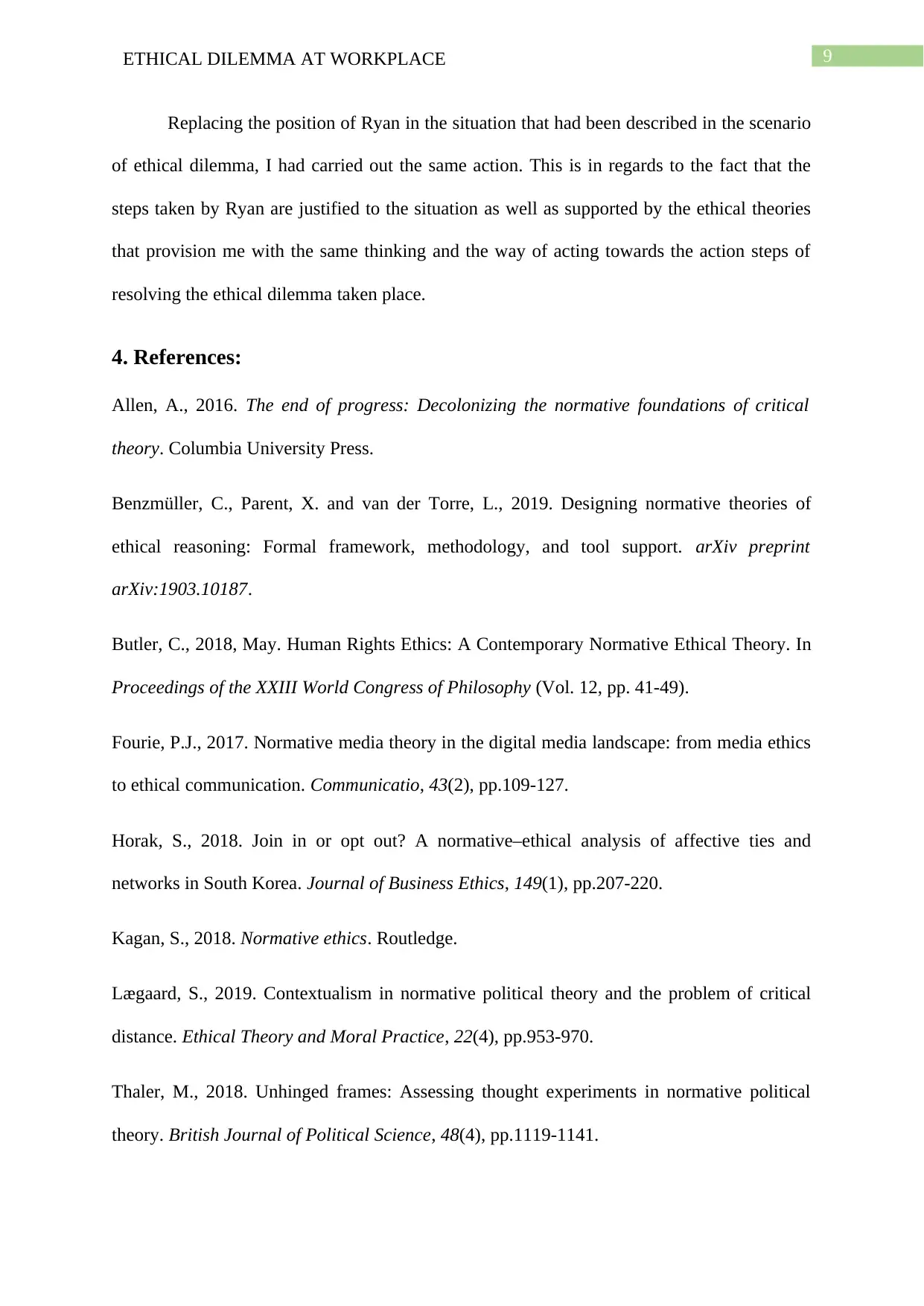
9ETHICAL DILEMMA AT WORKPLACE
Replacing the position of Ryan in the situation that had been described in the scenario
of ethical dilemma, I had carried out the same action. This is in regards to the fact that the
steps taken by Ryan are justified to the situation as well as supported by the ethical theories
that provision me with the same thinking and the way of acting towards the action steps of
resolving the ethical dilemma taken place.
4. References:
Allen, A., 2016. The end of progress: Decolonizing the normative foundations of critical
theory. Columbia University Press.
Benzmüller, C., Parent, X. and van der Torre, L., 2019. Designing normative theories of
ethical reasoning: Formal framework, methodology, and tool support. arXiv preprint
arXiv:1903.10187.
Butler, C., 2018, May. Human Rights Ethics: A Contemporary Normative Ethical Theory. In
Proceedings of the XXIII World Congress of Philosophy (Vol. 12, pp. 41-49).
Fourie, P.J., 2017. Normative media theory in the digital media landscape: from media ethics
to ethical communication. Communicatio, 43(2), pp.109-127.
Horak, S., 2018. Join in or opt out? A normative–ethical analysis of affective ties and
networks in South Korea. Journal of Business Ethics, 149(1), pp.207-220.
Kagan, S., 2018. Normative ethics. Routledge.
Lægaard, S., 2019. Contextualism in normative political theory and the problem of critical
distance. Ethical Theory and Moral Practice, 22(4), pp.953-970.
Thaler, M., 2018. Unhinged frames: Assessing thought experiments in normative political
theory. British Journal of Political Science, 48(4), pp.1119-1141.
Replacing the position of Ryan in the situation that had been described in the scenario
of ethical dilemma, I had carried out the same action. This is in regards to the fact that the
steps taken by Ryan are justified to the situation as well as supported by the ethical theories
that provision me with the same thinking and the way of acting towards the action steps of
resolving the ethical dilemma taken place.
4. References:
Allen, A., 2016. The end of progress: Decolonizing the normative foundations of critical
theory. Columbia University Press.
Benzmüller, C., Parent, X. and van der Torre, L., 2019. Designing normative theories of
ethical reasoning: Formal framework, methodology, and tool support. arXiv preprint
arXiv:1903.10187.
Butler, C., 2018, May. Human Rights Ethics: A Contemporary Normative Ethical Theory. In
Proceedings of the XXIII World Congress of Philosophy (Vol. 12, pp. 41-49).
Fourie, P.J., 2017. Normative media theory in the digital media landscape: from media ethics
to ethical communication. Communicatio, 43(2), pp.109-127.
Horak, S., 2018. Join in or opt out? A normative–ethical analysis of affective ties and
networks in South Korea. Journal of Business Ethics, 149(1), pp.207-220.
Kagan, S., 2018. Normative ethics. Routledge.
Lægaard, S., 2019. Contextualism in normative political theory and the problem of critical
distance. Ethical Theory and Moral Practice, 22(4), pp.953-970.
Thaler, M., 2018. Unhinged frames: Assessing thought experiments in normative political
theory. British Journal of Political Science, 48(4), pp.1119-1141.
Paraphrase This Document
Need a fresh take? Get an instant paraphrase of this document with our AI Paraphraser
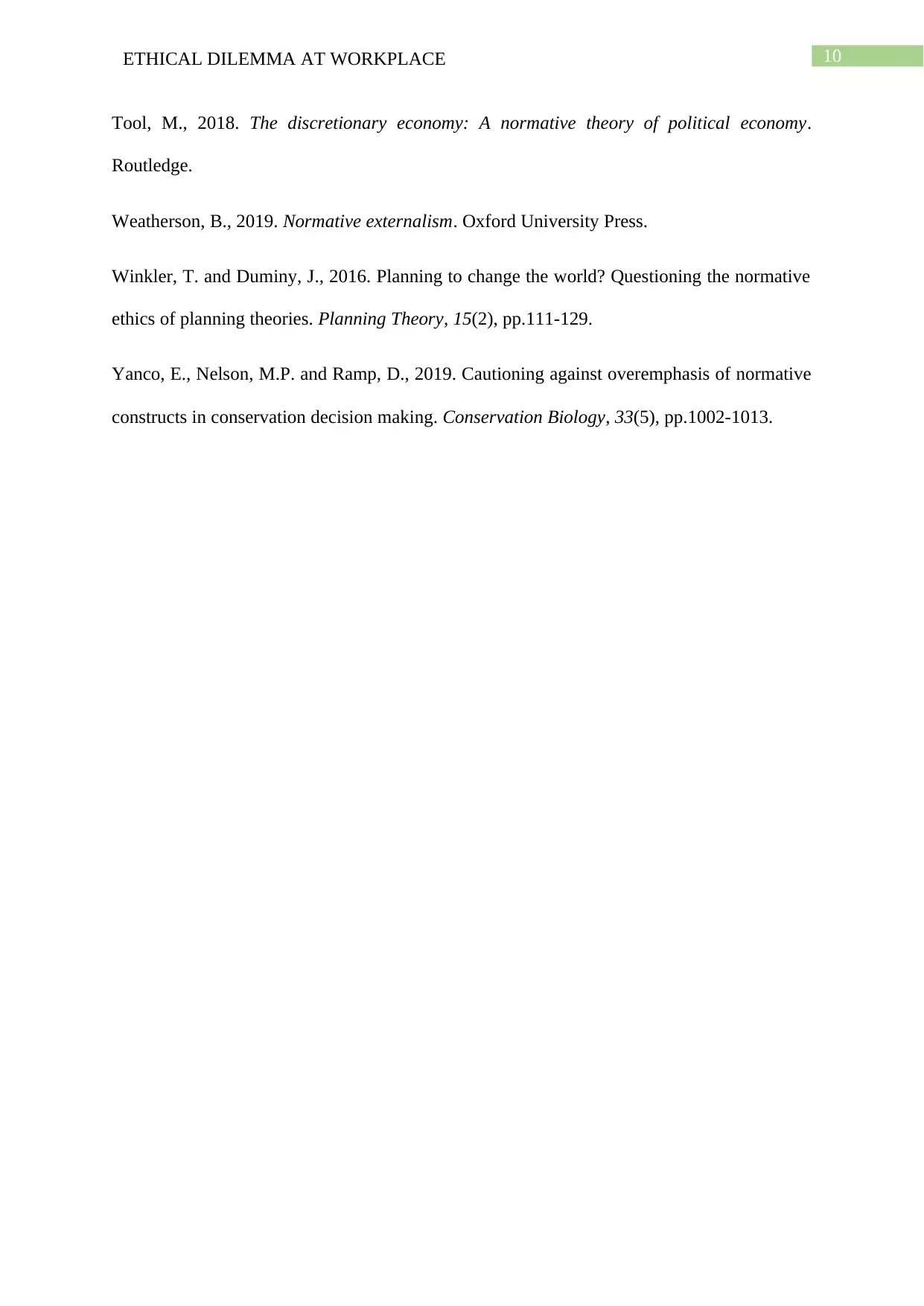
10ETHICAL DILEMMA AT WORKPLACE
Tool, M., 2018. The discretionary economy: A normative theory of political economy.
Routledge.
Weatherson, B., 2019. Normative externalism. Oxford University Press.
Winkler, T. and Duminy, J., 2016. Planning to change the world? Questioning the normative
ethics of planning theories. Planning Theory, 15(2), pp.111-129.
Yanco, E., Nelson, M.P. and Ramp, D., 2019. Cautioning against overemphasis of normative
constructs in conservation decision making. Conservation Biology, 33(5), pp.1002-1013.
Tool, M., 2018. The discretionary economy: A normative theory of political economy.
Routledge.
Weatherson, B., 2019. Normative externalism. Oxford University Press.
Winkler, T. and Duminy, J., 2016. Planning to change the world? Questioning the normative
ethics of planning theories. Planning Theory, 15(2), pp.111-129.
Yanco, E., Nelson, M.P. and Ramp, D., 2019. Cautioning against overemphasis of normative
constructs in conservation decision making. Conservation Biology, 33(5), pp.1002-1013.
1 out of 11
Your All-in-One AI-Powered Toolkit for Academic Success.
+13062052269
info@desklib.com
Available 24*7 on WhatsApp / Email
![[object Object]](/_next/static/media/star-bottom.7253800d.svg)
Unlock your academic potential
Copyright © 2020–2025 A2Z Services. All Rights Reserved. Developed and managed by ZUCOL.

